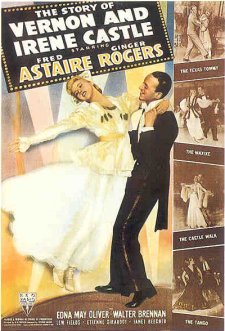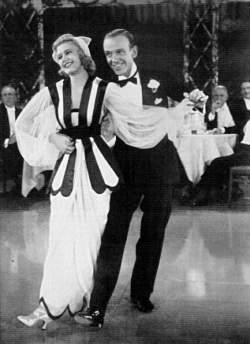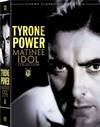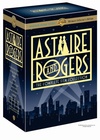


Ginger Rogers and Fred Astaire
Filmography | Lyrics | Articles | Awards | Downloads | Bibliography | Goofs | Statistics | Rankings | Links | Image Credits | Ginger Rogers | Fred Astaire
| Page 9 |
THE STORY OF VERNON AND IRENE CASTLE (1939) Prologue:
|
 A photo of the real Vernon and Irene Castle during the 1910s. If CAREFREE (1938) is the most comedic of the Rogers-Astaire films, then THE STORY OF VERNON AND IRENE CASTLE (1939) is by far the most serious. As the title implies, it is a biopic about Vernon and Irene Castle, one of the world's most famous ballroom dancing teams of the 1910s. The Castles helped popularize many of the ragtime dance steps that came to replace the cakewalk and the two-step during the 'teens when popular music finally began to erode the formalities of social dancing. And when RKO bought the film rights to Mrs. Castle's 1919 book about her husband, there was no question among the studio executives who would play this history-making dance team. As a Rogers-Astaire film, CASTLES is a departure in many ways. There is quite a bit of dancing in the film, but as one would expect in a biopic, the dances aren't those of the actors (Ginger and Fred) but rather those of their characters (Irene and Vernon). The style is (according to the prologue) from "a fabulous and beloved era, near enough to be warmly remembered," and though the film tries valiantly to illustrate how new and innovative the Castle dance steps were in their day, they just aren't as exciting as the standard Ginger and Fred had set by the time this film came along. Consequently, some of the usual "wow" is missing. The second major departure from the Rogers-Astaire norm is that CASTLES is not a comedy; it's a romance. Despite the presence of Walter Brennan, Edna May Oliver and several incomprehensible Frenchmen, it's the love story that dominates. Even the dancing is infused with it; no comedic tap-happy numbers here. While this isn't necessarily bad, it does put a lot of pressure on Astaire's performance as a credible romantic leading man. Astaire as an actor always romanced best by dancing, not by acting, and in CASTLES, the dancing is more an expression of love than a forum for the development of it. A minor point, but one that matters as romances with Astaire go. Lastly, CASTLES doesn't have a happy ending. As audiences of the time were well-aware, Vernon Castle was killed in a plane crash in 1918, and no movie about the famous couple could hope to gloss over this. While CASTLES attempts to invoke some uplifting sentiment about love transcending death, it can't overcome the fact that its love story has a tragic ending. As a result, CASTLES lacks the carefree, escapist mood of the earlier films. Stage-stuck Irene Foote meets vaudeville comedian Vernon Castle at the beach one day in New Rochelle when their shared love of animals leads both of them toward a drowning dog. As soon as Irene finds out Vernon is an actor, she stages an impromptu audition for him in her living room, doing an impression of Bessie McCoy dancing "The Yama Yama Man." Vernon is less than enthusiastic about her exhibition and eventually manages to make his way to the train station where he does a brief soft-shoe to "By the Light of the Silvery Moon" before heading back to New York. (It's nice, and as close as we come to an Astaire solo in the film.) Irene is enchanted and makes a trip to New York with some girlfriends to see Vernon appear in a show called "The Hen Pecks" with Lew Fields. But, when she discovers Vernon is actually a stooge in Fields' comedy routines and doesn't dance at all, she goes backstage to give him a piece of her mind.
"You were terrible," Irene tells him. "You could be a perfectly wonderful dancer if you wanted to, but instead you waste your talent letting people set fire to you... You call me a ham. Well, you're a ham with mustard!" Vernon doesn't appreciate her remarks, but they do set him thinking, and he soon finds himself spending his Sundays in New Rochelle. In the wink of an eye, they are dancing together in Irene's front parlor, preparing to audition for Fields. Then, with the encouragement of Irene, Walter Brennan and the Foote family (and despite his desire to "keep from getting involved"), three months after they meet, Vernon proposes. "You know, I think when people dance well together, it's because they're sympathetic to each other," he tells her. "Only When You're In My Arms," the love song Vernon sings to Irene in the parlor, is the only original song written for the film, and a nice one, if a little high for Astaire's range. |
The rest of the film describes the ups and downs of the Castles career as a dance team and married couple. As Mr. Fields comments after their audition for him (dancing The Texas Tommy to "Waiting for the Robert E. Lee" -- one of the most fun and entertaining dance numbers in the film): "Who's going to pay money to see a man dance with his wife?" Eventually everyone, but it takes a while. After some hard times in Paris, the Castles finally get a chance to show their stuff (which they've dubbed The Castle Walk -- another lively number) at the Café de Paris. The film's "Rise-to-Fame Montage" exhibits several of the dances which the Castles helped to make famous, including The Tango (danced to "Rose Room"), The Fox Trot (danced to "Très Jolie"), The Polka (danced to "Little Brown Jug") and The Maxixe (at right, danced to "Dengozo"). The "Rise-to-Fame Montage" also demonstrates the Castles' influence on popular culture, from Irene's trend-setting clothes and hair-style to the couple's success merchandising everything from dancing shoes to beauty cream with their name on it. World War I breaks out soon after the end of their whirlwind tour of the United States however, and the drama of lovers in wartime quickly takes over. One more dance that is worthy of note however, takes place mid-war during their brief Parisian reunion. Vernon arrives in uniform at the Café de Paris just in time to dance with Irene to a medley of waltzes. The number features a lift in which Ginger locks her arms down by her sides and Fred picks her up from behind by her fists. It doesn't sound like much when I describe it, but it's a lovely move and contributes nicely to the romantic mood of the scene. THE STORY OF VERNON AND IRENE CASTLE is a better romance than a Rogers-Astaire musical, but even as a romance, it has a tendency to follow the episodic development which so often plagues "true stories" on the big screen. Still, it's a nice film, and one that gives both Fred and Ginger a chance to demonstrate a wider dramatic range than their films usually called for. Finally, the story of the Castles is interesting from a historical perspective -- not so much as a demonstration of their innovation and influence however, but rather as a reminder of what dancing looked like before Ginger and Fred came along. Overall, CASTLES is not as rousing as the other Rogers-Astaire films, but it is still worth seeing if for no other reason than it helps the audience to better appreciate the singular influence of Fred and Ginger and their films on the evolution of dance in the 20th century. |
Go to the next page. |
| Current Contest Prize: |
|---|
| Now in Print! |
|---|
| Now on DVD! |
|---|
Buy Videos & DVDs |
|
Buy Movie Posters |
|
Buy Movie Posters |
|
Classic
Movie Merchandise |
|
![]() Printer-friendly version.
Printer-friendly version.
![]() Return
to the top.
Return
to the top.
Last updated:
December 16, 2008.
Reel Classics is a registered trademark of Reel Classics, L.L.C.
© 1997-2009 Reel Classics, L.L.C. All rights reserved. No
copyright is claimed on non-original or licensed material.
Terms of
Use.












